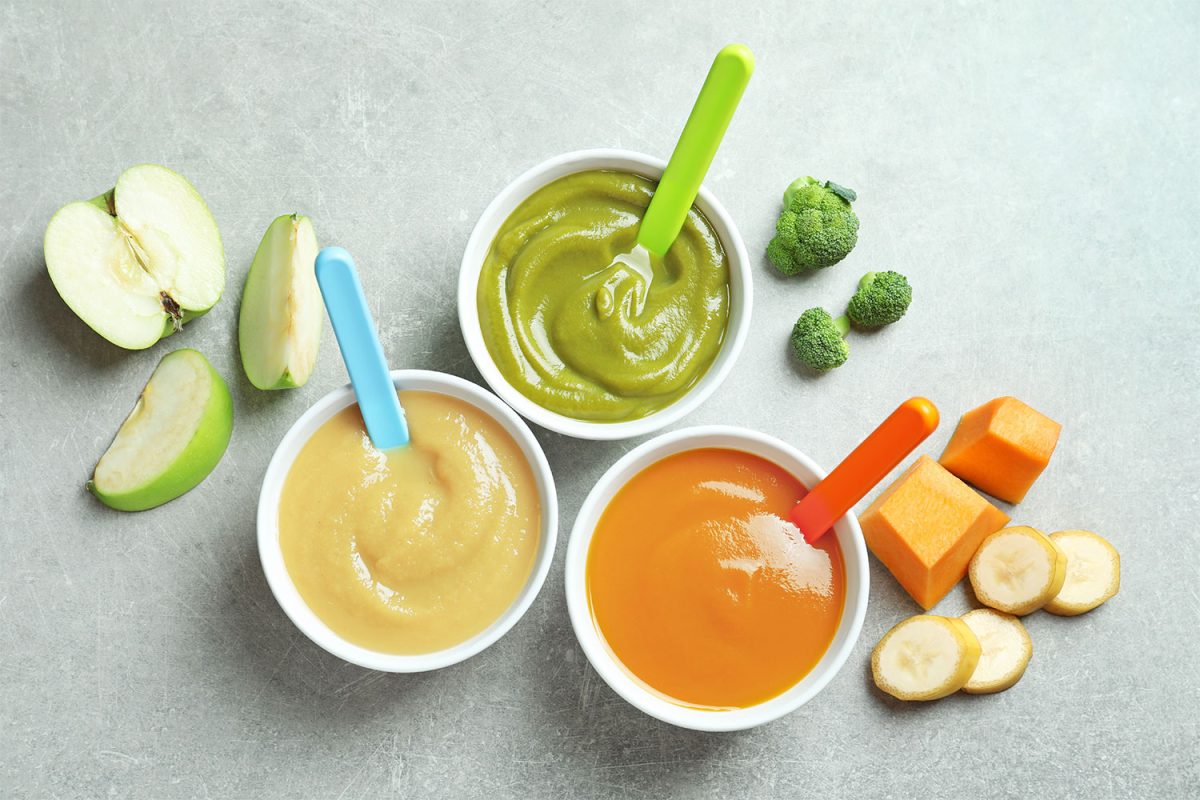Introducing your infant to the joys of “real food” is exciting. It’s a major milestone for your little love and a game-changing event for parents. You now have to work actual meal times into your routine, and balance breastfeeding, formula feeding, and spoon-feeding your hungry little hippo. But before you get carried away imagining all the delicious fun you’ll have sharing ice-cream sundaes and stealing nibbles from chicken nuggets; you’ll need to help your munchkin graduate beyond the basics. Don’t worry, it doesn’t have to be all boring pea purees and apple sauce; you can get creative in the kitchen and inspire your eager eater to be an adventurous taste tester. If you want to get some starter info and learn a few fun (and yummy) combos to try, read on for our tasty tips.

Ready to start solids?
Think your little one is ready for jars, pouches, and homemade purees? Most pediatricians recommend introducing solids sometime between four and six months of age (when in doubt, talk to your child’s doctor, of course). Your baby doesn’t need anything other than breast milk and/or formula up until this point. But if your wee one has reached the appropriate age and is start giving you some tell-tale clues, you can gradually begin introducing some options. Is your baby able to hold their head up steadily? Have they lost that reflexive tongue thrust? Do they stare longingly when you put food into your own mouth? If so, it’s probably time.
How to start
For a long time, pediatricians recommended introducing a rice or oatmeal cereal first. And while you can stick to a traditional whole-grain, iron-fortified option combined with breast milk or formula as your baby’s first bite, you can also try something a little more interesting.
Vegetables are another great way to go. Start with the yellow and orange options. Carrots and sweet potatoes are chock full of vitamins and nutrients and have a hint of sweetness your baby will likely love. Next, graduate to the heartier green purees. Peas, string beans, and spinach tend to have stronger flavors.
Fruit, of course, is always a delightful option. However, some pediatricians will recommend waiting to offer fruit purees until you’ve introduced a variety of vegetables, as you don’t want your little one to develop a preference for super sweet flavors. Apples, pears, peaches, prunes, bananas, and mango may be among your little one’s favorites.
A finely mashed avocado is a creamy nutrient-dense alternative your baby may like from the get-go. If your baby doesn’t enjoy mashed avocado, remember that every baby reacts differently to unique flavors and textures.
Whatever order of introduction you decide to use, you will need to be careful and cautious about introducing too many foods too close together. You want to be able to identify any potential allergies, so you don’t repeat the offending food. To this end, wait a few days in between new offerings.

Delicious combos you can make or buy
Once you’ve introduced the main vegetables and fruits, you can start to get a little fancier in your baby-food making (or jar mixing) pursuits. Fruits and vegetables are a perfectly palatable pair, so try new baby food combinations and see what pleases your tiny tot’s palate.
In the meantime, some signature match-ups are usually a hit with the infant crowd. These are just some initial ideas to get the creative culinary juices flowing. If you plan to make your own food, you can play around and literally mix it up. In the meantime, try these 10 winning combos to see how your baby reacts.
- Apple and broccoli
- Apple and carrot
- Apple and spinach (feel free to also add blueberries to make this delicious duet and tasty trio!)
- Banana and avocado
- Bananas, blueberries, and baby oatmeal
- Carrot, pumpkin, and sweet potato
- Mango and kale
- Pear and butternut squash
- Pears and zucchini
- Purple carrots and blueberries
DIY or buy?
You may have lofty goals to make your own baby food from scratch. Nowadays, there are ample tools to make this process much easier and more efficient. It’s fine if you choose to steam, blend, mash, freeze, and thaw your own baby food, but it’s also just as acceptable to buy pre-packaged baby food mixes. While DIY-ing allows you to have more control over proportions and combinations. BUY-ing and choosing jars and pouches should not be considered a compromise. Baby food has come a long way; there are organic options chock-full of the good stuff and they are healthy and convenient so it’s hard to justify not using them.
What about food allergies?
While introducing solids can be a source of pleasure, it can also produce anxiety for parents, especially if they a family history of food allergies. Talk to your pediatrician to develop a plan of action for introducing new foods to your baby in a safe and smart way. The most common food allergens are dairy milk, eggs, tree nuts and peanuts, seeds, soy, wheat, corn, and berries. While you might think avoiding these options altogether is the answer, research has shown that earlier introduction to these common culprits can reduce the risk of allergy development. If you are nervous about specific foods and get the go-ahead from your pediatrician, try adding a bit to a mix that has already been well established with your child. Keep an eye out for the sudden onset of eczema-like symptoms such as hives, swelling, shortness of breath, and gastrointestinal distress. Seek immediate medical help if your child appears to be in serious anaphylactic distress.
Some helpful tips
- It can take 10 to 15 tries for your baby to develop a taste for a certain food so don’t get discouraged if your little one turns their tiny nose up at your homemade puree. Keep trying; they may change their mind (or not!). Either way, variety is the spice of life so offer lots of different fruits and veggies.
- When mixing fruit with a more aggressively flavored green veggie (i.e. apple and broccoli), start with a larger amount of the sweet fruit. Slowly add more and more broccoli to get your baby accustomed to its unique taste.
- Adding some baby oatmeal into fruit and veggie mixes is a great way to give your eater a source of whole grains and iron. These options tend to go well with just about anything.
- Your baby will be able to tolerate thicker mixes as they learn the ropes of eating solids. To begin with, you’ll want all your purees to be extremely smooth and thin. You can gradually make them thicker, and even incorporate blended meats and proteins into your mixes.
- All these new food options can cause digestive troubles for your baby’s tiny tummy. If your little one seems gassy or uncomfortably constipated, you can always try a jar of prunes or mix some into your puree since prunes can have a laxative effect.
Welcome to the solids stage! It’s going to be full of trial and error, smiling, gagging, and drooling. Take it slow and experiment; you’ll find the combinations that work for your puree-pounding cutie pie. And if you’re looking for more examples, check out our list of solid baby-friendly meals for starters. Enjoy!


